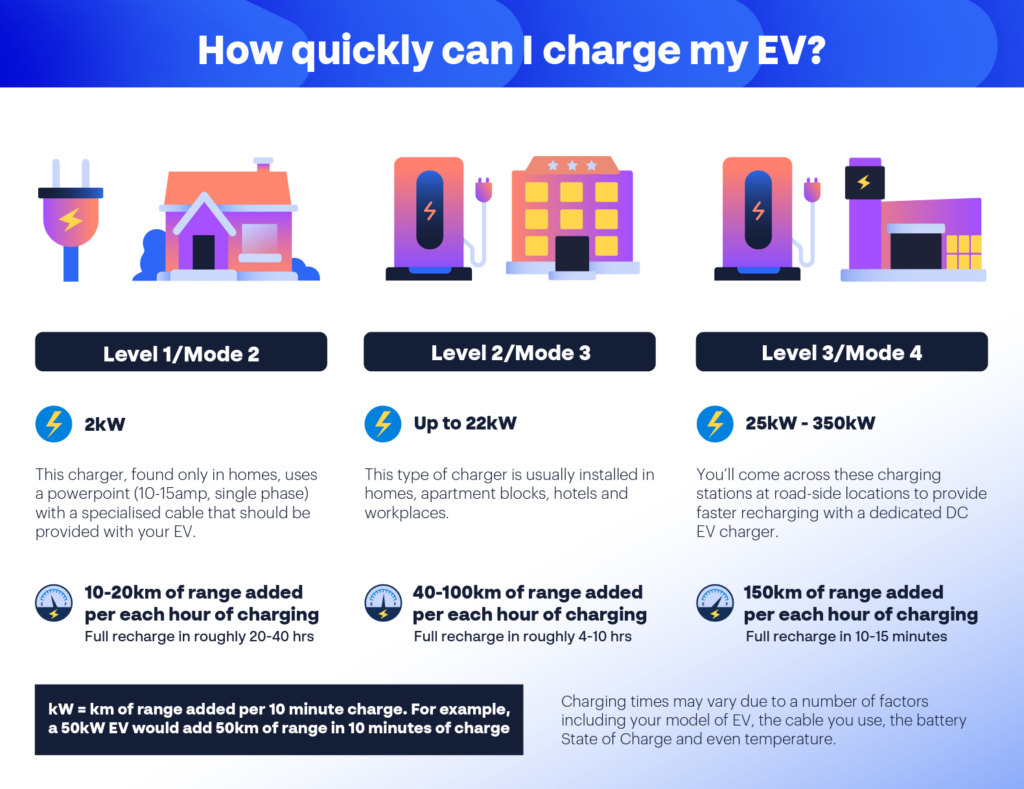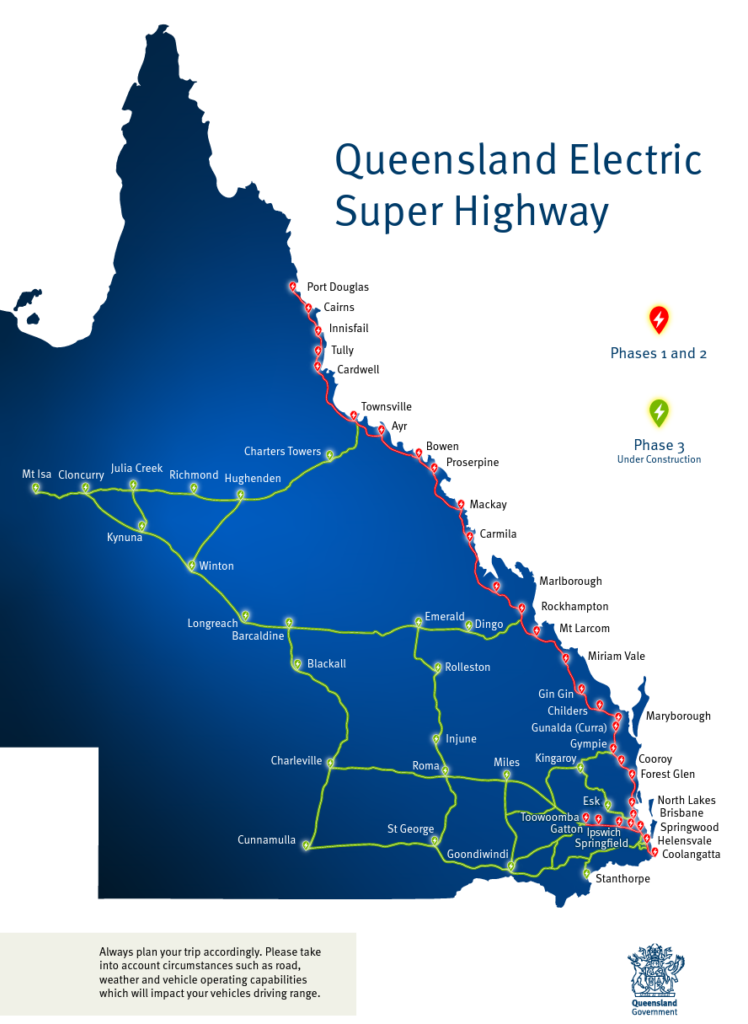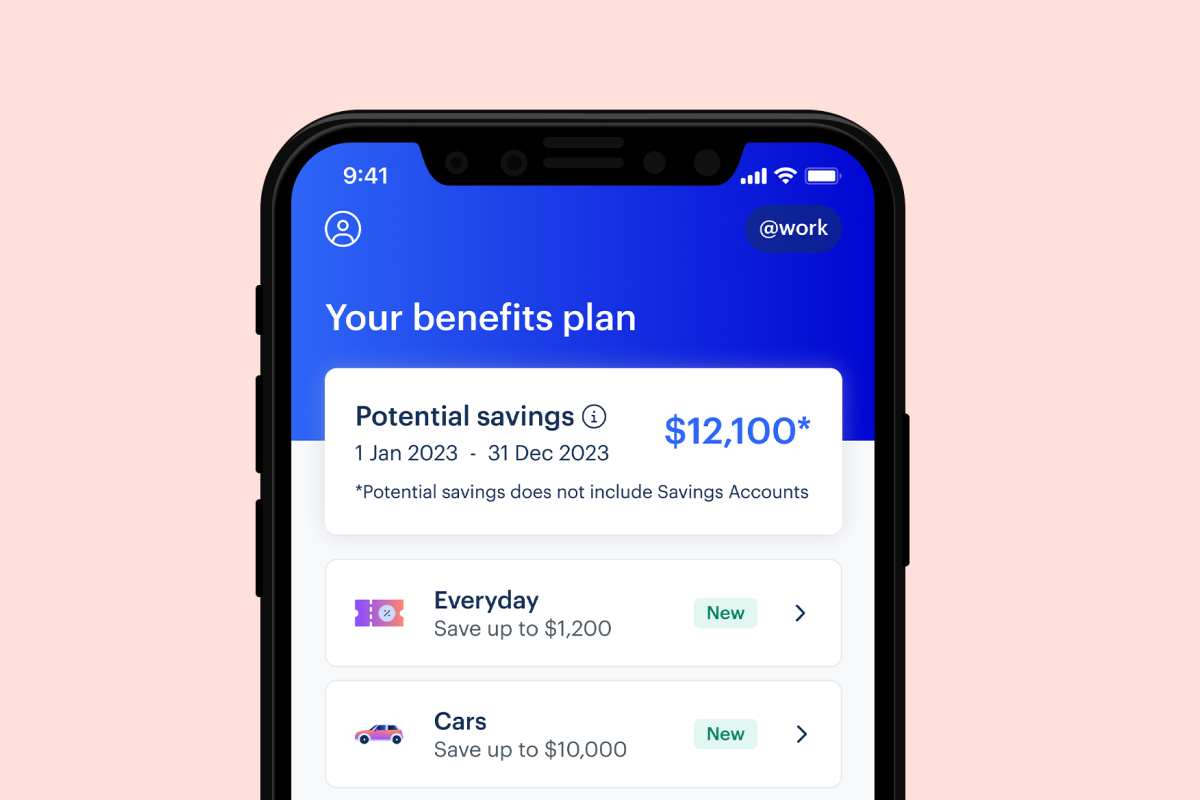Our country is embracing the future of transportation, with South Australia leading the charge (pun intended).
From the bustling streets of Adelaide to the tranquil vineyards of the Barossa Valley, there’s a growing network ensuring that electric vehicle (EV) owners never find themselves out of juice.
Let’s explore the state’s EV landscape and how South Australia is making strides to ensure that when it comes to charging, power never goes ‘south’.
How many electric charging stations in South Australia?
The EV infrastructure in South Australia is growing rapidly, making it easier for EV owners to find chargers across the state.
As of mid-2023, South Australia is home to a total of 238 public charging stations. This includes 193 regular AC chargers, 36 fast DC chargers, and 9 ultrafast DC chargers. These different types of chargers cater to various charging needs, from everyday use and city driving to long-haul journeys.
Public charging locations by region and power level - as of 30 June 2023
| State/Territory | Fast (24kW - 99kW DC) | Ultrafast (100kW DC & above) | Total |
|---|---|---|---|
| ACT | 6 | 3 | 9 |
| NSW | 131 | 43 | 174 |
| NT | 3 | 0 | 3 |
| QLD | 93 | 16 | 109 |
| SA | 42 | 9 | 51 |
| TAS | 31 | 5 | 36 |
| VIC | 97 | 32 | 129 |
| WA | 36 | 12 | 48 |
| Grand Total | 438 | 120 | 558 |
Source: The Electric Vehicle Council
The regular AC chargers are perfect for daily use and are typically found in residential areas, shopping centres, and public car parks. Fast DC chargers and ultrafast DC chargers are ideal for long-distance travel, capable of adding hundreds of kilometres of range in just minutes.
In addition to these public charging stations, the Royal Automobile Association (RAA) is forging ahead with the expansion of the EV charging network across South Australia.
Over 59 charging stations are currently available across Marion, West Lakes, Strathalbyn, Hahndorf, Woodside, Mt Gambier, and five UParks sites in the Adelaide CBD.
RAA’s 200kW Ultra-rapid charging site has recently come online in Burnside. With this station, RAA Charge reaches 71 operational sites, including sixty-eight 7kW destination chargers and three 200kW Ultra-fast or 150kW fast charging sites.
This initiative by the RAA and the local government aims to build South Australia’s first border-to-border network of EV charging stations.
Over 59 charging stations are currently available across Marion, West Lakes, Strathalbyn, Hahndorf, Woodside, Mt Gambier, and five UParks sites in the Adelaide CBD.
RAA’s 200kW Ultra-rapid charging site has recently come online in Burnside. With this station, RAA Charge reaches 71 operational sites, including sixty-eight 7kW destination chargers and three 200kW Ultra-fast or 150kW fast-charging sites.
This initiative by the RAA and the local government aims to build South Australia’s first border-to-border network of EV charging stations.
South Australia’s border-to-border EV charging network
RAA has partnered with the South Australian Government to develop an extensive network of electric car charging stations in the region. Supported by a $12 million State Government grant, construction has already begun.
By 2024, the network will include 140 charging locations covering SA border-to-border:
- 98% of chargers less than 200km apart
- 75% of charging locations in regional SA
- All sites powered by 100% renewable energy
A total of 536 charging bays will be available at future locations throughout the Adelaide Hills, Barossa, Clare Valley, Eyre Peninsula, Fleurieu Peninsula, the Flinders Ranges, the Outback, Kangaroo Island, Limestone Coast, Murray River, Lakes and Coorong, Riverland and Yorke Peninsula areas.
With the completion of this project, driving an electric vehicle in South Australia will become easier than ever.

Source: Government of South Australia
Where to charge your EV in Adelaide
As part of their commitment to supporting the uptake of electric vehicles, the City of Adelaide has installed a total of 54 charging stations located across the city and North Adelaide.
Some of the key locations include:
- 70 Light Square, Adelaide – 2 x 22kW charging points
- 47 Hindmarsh Square, Adelaide – 2 x 22kW charging points
- 61 Jerningham St, North Adelaide – 2 x 22kW charging points
- 109 Franklin St, Adelaide – Electric Vehicle Charging Hub – 2 x 22kW charging points, 2 x 50kW charging points, and 4 x Tesla-owned charging points
In addition to these on-street charging stations, the City of Adelaide’s off-street electric vehicles charging stations are located at various UPark carparks.
The city has also partnered with Chargefox, Australia’s largest and fastest-growing EV charging network. Chargefox has several charging stations in Adelaide, including locations at Jerningham Street in North Adelaide and Greenhill Road in Tusmore.
With Plugshare, you can find the most up-to-date information on charging stations in Adelaide.
City of Adelaide’s incentives
The City also supports residents and businesses to move to all-electric homes and vehicles, as part of its mission to become one of the world’s first carbon neutral cities.
Here are the incentives they offer to encourage the installation of EV chargers:
- 50%, up to $1,000, for installing an EV one way charging station (7kW to <50kW) at a residential or commercial property.
- 25%, up to $2,000, for installing an EV ‘smart’ charging station (7kW to < 50kW) at a residential or commercial property. Smart stations include those with demand management capabilities or two-way charging capabilities.
Map of EV charging stations in South Australia
Wondering how to pinpoint charger locations and types on a map?
Companies like PlugShare, Chargefox, and the EV Council offer real-time maps that pinpoint nearby stations and provide key details like charging speed, payment methods, and invaluable user reviews.
Did you know that with Google Maps’ charging feature, planning an EV escapade has never been easier? If your EV is equipped with Google Maps, you can easily plan charging stops throughout your adventure. With this navigation app, you’ll always be charged up and ready to go.
Here are the top interactive maps you should consider bookmarking:
Costs of running an EV in South Australia
It costs money to charge an EV in South Australia, but the cost is typically less than refuelling a petrol or diesel car.
Public EV charging stations in Australia, on average, cost around $0.45 per kWh for a 50kW DC fast charging station.
Domestic charging, however, is generally the most economical option, costing approximately $0.20 per kWh on average.
While talking about expenses, it’s important to note that the South Australian Labor Government has recently repealed a tax previously applied for every kilometre driven in an electric vehicle. This could significantly reduce running costs for EV drivers in South Australia.
Plus, there’s other avenues for South Australians to reduce costs on their EVs.
A three-year exemption on motor registration costs and an enticing $3,000 EV subsidy (applicable only for vehicles priced up to $68,750 incl GST) are available.
Nationally, the Australian government also offers compelling incentives. New EVs and PHEVs purchased post 1st July 2022 that are priced below the luxury car threshold of $89,332 are exempt from the Fringe Benefits Tax (FBT). This paves the way to potentially negotiate an EV package with your employer, bringing in tangible tax benefits.
Discover how Flare can reduce your car running costs and help simplify your life by switching to an EV novated lease.
EV Charging in South Australia
Let’s delve into the ins and outs of charging your EV in South Australia.
How long does it take to recharge in South Australia?
The time it takes to charge your EV in South Australia is dictated by the charger type and your vehicle’s battery.
For instance, using Fast DC chargers, you can achieve up to 80% charge in just 20-30 minutes.
Here’s a snapshot of what you can expect in terms of charging duration:
| Charge rate (kW) | Range gained per hour | Range gained per 15 minutes |
|---|---|---|
| 2.2 | 15km | 3.75km |
| 3.7 | 25km | 6.25km |
| 7.7 | 40km | 10km |
| 11 | 65km | 16.25km |
| 22 | 130km | 32.5km |
| 50 | 300km | 75km |
| 150 | 900km | 225km |
| 350 | 900km | 225km |
Source: NRMA
Several factors play a role in determining the charging speed of your EV.
Among these are:
- Charging level and mode. Dive deeper into this with our guide on Australian EV charging stations.
- Charging equipment, which includes the plugs, points, and cables, with some designed for more rapid power outputs.
- On-board charging capacity and size of a vehicle’s battery.
- Battery’s State of Charge (SoC), as charging speeds up from a lower SoC but slows down as it surpasses 80%.
- Battery temperature. Extreme climates can affect a battery’s charging pace.

Now let’s take a glimpse into David’s EV routine.
David calls South Australia home and loves every bit of his Nissan Leaf. During the week he drives to the office, the gym and the markets, racking up about 35km. Thanks to his trusty Level 2 charger at home, he secures around 25km of drive time each hour he plugs in.
Weekends for David are all about unwinding, and the Barossa Valley or the historic city of Port Adelaide are often on his R&R list. Strategic pit-stops at cafes boasting fast chargers means his Leaf is always ready to go, often gaining an extra 100km boost during a leisurely coffee break.
How far can you drive on a full charge in South Australia?
The distance you can cover on a single EV charge varies based on a myriad of factors: the vehicle’s make and model, the battery’s health, the conditions in which you’re driving, and even the day’s weather.
Most EVs, like the Tesla Model 3, BMW iX, and Kia EV6, generally offer between 250 and 300km on a full charge.
To give you an idea, the daily commute for a typical South Australian is around 35km. This distance is comfortably within the capabilities of most EVs.
With a Level 2 charger at home, you’ll wake up to a fully charged car, ready for more than just the daily commute.
Considering an EV for South Australia? Simply compare the advertised range with your daily driving routine to see if it suits your lifestyle.
Charging Ahead in South Australia
South Australia is truly electrifying its roadways, boasting nearly 240 charging stations, and the future looks even brighter with the border-to-border EV network currently in development.
The latest EVs can cover distances between 250 and 300km on a full charge. When you factor in that the average South Australian drives a mere 35km daily, and that fast and ultra-fast charging stations can top up your battery in a matter of minutes, you can confidently bid goodbye to range anxiety.
Want to walk the sustainability talk and take advantage of the cost savings?
Look into a Flare novated lease
FAQs – EV chargers in South Australia
Are there enough EV charging stations in South Australia?
South Australia is making impressive strides in EV infrastructure with nearly 238 charging stations available as of mid-2023. With the RAA and the South Australian Government’s initiative, a border-to-border EV charging network is in the pipeline. By 2024, this network alone will boast 140 charging locations, ensuring widespread coverage and accessibility for EV owners.
Are EV charging stations free in South Australia?
In South Australia, some public EV charging points, especially the slower AC ones in shopping centres and public car parks, offer free charging. Many hotels and restaurants also provide complimentary charging for their customers.
However, the majority of public charging stations, especially the faster DC chargers, come with a fee. The cost can vary depending on the time of day and the specific network.
What’s the average cost to charge an electric car in South Australia?
On average, public EV charging stations in South Australia charge around $0.45 per kWh for a 50kW DC fast charging station.
How much does it cost to charge an EV at home in South Australia?
The average cost for at-home charging in South Australia is approximately $0.20 per kWh. However, the actual cost can vary depending on the time of day, the electricity provider and the plan you choose.
But if you have solar panels, charging your EV could effectively be free when the sun is shining — and we all know that happens often in South Australia!
What is the cheapest EV charging network in South Australia?
The RAA Charge network is often the cheapest with 32c/kWh during evening peak times (5pm-10pm) and 23c/kWh at all other times for their 7kW destination charging sites. However, these can vary; it’s always a good idea to check the charging costs before topping up.
How long does it take to charge an EV at a fast charging station in South Australia?
At a fast charging station in South Australia, it typically takes between 15 to 45 minutes to fully charge an electric vehicle. But remember that the charging time depends on the vehicle’s battery capacity, the current level of charge, and the station’s power rating.
What is the difference between a fast-charging station and an ultra-fast charging station in South Australia?
In South Australia, fast chargers usually provide power between 24kW and 99kW DC, while ultra-fast chargers start at 100kW DC.









































